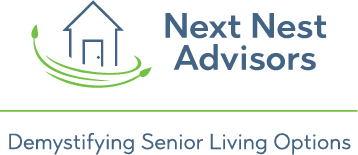Top Questions When Considering a Move to a Senior Community
When should I begin thinking about a move to a senior community?
When you’re still healthy! Ideally, you would like to make the move when you still have the energy to physically go through the process and then enjoy your new surroundings. Many communities have wait lists that are 2-4 years, so, you should be thinking about moving well IN ADVANCE of when you’d actually like to relocate. Ideally, you should begin to identify where you might like to move in your early 70s. Placing a deposit on one or two communities can give you options for the future just in case you need to make the move sooner than planned.
What are the different kinds of senior communities?
There are 55+ communities, continuing care retirement communities (CCRCs) or life plan communities, and fee-for-service communities. The main difference between the three is related to medical care. Generally, 55+ communities have no direct access to medical services, but offer living arrangements and amenities appealing to those who are 55+ or retired. A CCRC provides the full-spectrum of care through the entirety of your life from independent living, to personal care, to skilled nursing and even memory support. The monthly fee is established with the housing you choose at the onset and will cover you for the remainder of your life with modest yearly increases. A fee-for-service community generally has access to the full spectrum of care, but the fees for care are not included in the initial monthly contract when you move into independent living. As you move through the care continuum, fees will change as your medical needs increase and you relocate; you pay for medical care when you receive it, not bundled in advance as with a CCRC.
What are the financial implications of a senior community contract?
It depends on the community and the contract structures offered. For example, one community may offer a non-refundable option where the entrance fee is amortized 2% per month for 50 months. In other words, after you have lived in the community for just over four years, there will no longer be any entrance fee to be refunded. Another option could be a 50% refundable entrance fee. In this case, you would receive 50% of the entrance fee (and possibly more) if you vacate the unit within the first four years of occupancy. Entrance fees tend to be lower for non-refundable options. In addition, some communities consider the purchase into the community a real estate transaction subject to market forces while others do not. All of these details need to be considered and evaluated when choosing a senior living community.
How do I find the community that is right for me?
Visit several for a tour and discussion with the marketing and finance departments. Attend special events in different communities and even consider an overnight stay to get to know them better. Meet and spend time with current residents and staff to determine if you would feel comfortable within the community.
What’s involved when entering a CCRC?
Generally, a CCRC or life plan community will conduct a thorough review of your financial means along with a medical and mental evaluation. If a couple is planning to move together, both members of the couple need to satisfy the requirements of independent living to enter a CCRC. Very often, a CCRC will not allow a resident to change care requirements (e.g., move to personal care) within a defined period of time of moving in, such as 90 days. For these reasons, it is essential to make this move while you are still healthy and up to the task of moving.
how does a ccrc assess me or my loved one before moving in?
Traditional CCRCs or life plan communities that offer a full continuum of care over one’s lifetime (not fee-for-service CCRCs or rental communities) will evaluate you or your loved one to determine that you can safely live independently upon entering their community.
They will consider activities of daily living (ADLs), which are activities in which you engage daily. These every day, personal care activities are fundamental to caring for yourself and maintaining independence:
Walking: or otherwise getting around the home or outside
Feeding: being able to get food from a plate into one’s mouth
Dressing and grooming: selecting clothes, putting them on, and adequately managing one’s personal appearance
Toileting: getting to and from the toilet, using it appropriately, and cleaning oneself
Bathing: washing one’s face and body in the bath or shower
Transferring: able to move from one body position to another, e.g., bed to a chair, into a wheelchair, standing up from a bed or chair in order to grasp a walker or other assistive device
In addition, CCRCs will assess Instrumental Activities of Daily Living (IADLs), which are activities related to independent living. IADLs are valuable for evaluating individuals with early-stage disease, both to assess the level of disease and determine the person’s ability to care for himself or herself. These are tasks that require more complex thinking skills, including organizational skills:
Managing finances: paying bills and managing financial assets
Managing transportation: driving or organizing other means of transport
Shopping and meal preparation: everything required to get a meal on the table and shopping for clothing and other items required for daily life
Housecleaning and home maintenance: cleaning kitchen after eating, keeping living space reasonably clean and tidy, and keeping up with home maintenance
Managing communication: telephone, mail, email
Managing medications: obtaining medications and taking them as directed
These ADL and IADL functions will be assessed on the scale:
Independent
Needs Help
Dependent
Cannot Do
I hit the jackpot when I spoke with Catherine Twitmyer from Next Next Advisors. She provided me with several doable options concerning the long-term care for my elderly mother. I highly recommend her services. -Mary
